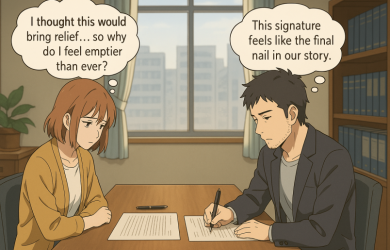5 Signs of Domestic Avoidance in Marriage & Ways to Cope

Unlock Daily 30-Sec Tips for a Happier Relationship
👉 Subscribe FREEKey Takeaways
Marriage.com AI Quick Summary
Marriage should be a source of comfort and companionship, but sometimes, it encounters problems that can weaken the connection between partners.
Imagine a couple where one partner begins to spend more time at the gym or with friends, seemingly avoiding coming home. At first, this might seem like a new interest or a busy social calendar. However, as this behavior persists, it becomes clear that the real issue isn’t about the activities at all; it’s about avoiding time together at home.
This situation points to a common relationship challenge known as avoidance in marriage. Understanding and tackling this issue is essential for maintaining a healthy and supportive partnership.
What is domestic avoidance in marriage?
Domestic avoidance in marriage refers to the behavior where one or both partners actively avoid spending time together or engaging in meaningful interactions within their domestic life.
This form of avoidance in marriage can manifest through extended hours at work, excessive engagement in hobbies or social activities without the other, and general withdrawal from shared responsibilities and communication.
Essentially, domestic avoidance in marriage is an attempt to escape from underlying issues or dissatisfaction within the relationship, leading to a physical and emotional distance between partners. It’s a coping mechanism that, while offering temporary relief, can significantly strain the marital bond.
What causes domestic avoidance?
Domestic avoidance in marriage is a complex issue with various underlying causes. Understanding these reasons is crucial for addressing and overcoming the problem. Here, we explore the main factors that lead to avoidance behaviors between partners, shedding light on this challenging aspect of marital relationships.
- Unresolved conflicts: When issues remain unresolved, it can lead to avoidance in marriage as one or both partners may feel it’s easier to avoid interaction than face the problems.
- Lack of emotional connection: A diminishing emotional bond can lead to domestic avoidance in marriage, as partners may feel less inclined to share their time and space.
- Stress and external pressures: High levels of stress from work, family, or financial issues can make a person retreat into themselves, avoiding their partner and home life.
- Fear of confrontation: The dread of arguments or facing uncomfortable truths can make a partner avoidant, preferring solitude or external distractions to facing marital issues.
- Dissatisfaction with the relationship: When one or both partners are unhappy with the state of their marriage, they might start avoiding home to escape feelings of discontent.
- Lack of independence: Feeling trapped or suffocated in a relationship can lead to one seeking freedom and space by avoiding their partner and domestic responsibilities.
- Communication breakdown: Poor communication skills or misunderstandings can lead to a cycle of avoidance, where it becomes easier to stay away than to try and talk things through.
5 signs of domestic avoidance
Avoidance in marriage can be a silent relationship killer. It’s crucial to recognize the subtle signs before they escalate into larger issues. Understanding these behaviors can help in addressing the underlying problems effectively. Here’s a deeper look into the indicators of avoidance in a marital setting.
1. Spending less time at home
A classic example of avoidance in marriage is when one partner starts spending less time at home. This behavior is often a way to escape from facing unresolved issues or discomfort within the relationship. It’s not just about working late; it’s about consistently finding reasons to be elsewhere.
According to Grady Shumway, LMHC
When home no longer feels like a place of connection, distance often becomes a silent substitute for difficult conversations. Recognizing the pattern is the first step toward healing what’s been left unspoken.
2. Lack of communication
A conflict avoidant partner may resort to minimal communication to dodge potential disagreements or uncomfortable topics. This avoidance tactic can lead to a breakdown in understanding and empathy between partners, as important issues remain unaddressed.
3. Disinterest in shared activities
When one partner shows a sudden disinterest in activities they once enjoyed together, it could be a sign of avoidance in the relationship. This change often reflects a deeper issue, as the individual may be trying to create emotional distance or avoid situations that could lead to confrontation.
4. Avoiding discussions about the relationship
Avoidance in marriage is also evident when one partner consistently dodges conversations about the relationship’s health or future. This can be particularly frustrating for the other partner who seeks to address and resolve underlying issues.
5. Physical or emotional withdrawal
Examples of avoidance include physical or emotional withdrawal within the marriage. This behavior is a clear sign that one partner is trying to protect themselves from potential hurt or conflict, leading to a significant gap in the couple’s emotional connection and understanding.
How does domestic avoidance affect a marriage: 5 ways
Domestic avoidance in marriage is a critical issue that can undermine the foundation of a relationship. Understanding how this behavior affects the marital bond is essential for couples facing this challenge. Here, we delve into the nuances of how avoidance in marriage impacts the dynamics between partners.
1. Communication breakdown
Avoidance in marriage leads to a significant communication breakdown. And this can be particularly harmful as communication is the heart of any relationship, as per research.
This barrier prevents couples from addressing their problems, causing misunderstandings and a pile-up of unresolved issues. The resulting silence creates a divide, hindering the ability to connect and collaborate effectively within the relationship.
2. Emotional distance
The presence of avoidant attachment in marriage exacerbates emotional distance between partners. As avoidance continues, the emotional bond weakens, leaving individuals feeling isolated and unsupported. This detachment is detrimental to the marriage, eroding the sense of unity and companionship that should characterize a committed relationship.
3. Resentment
Domestic avoidance in marriage can lead to deep-seated resentment. When one partner constantly avoids the other, feelings of neglect and undervaluation emerge. This resentment, if left unaddressed, can evolve into persistent anger and bitterness, poisoning the marital environment and making reconciliation more difficult.
4. Decreased intimacy
Avoidance behaviors contribute to a decrease in intimacy, a fundamental aspect of a healthy marriage.
As partners become more distant, their emotional and physical connection dwindles, leading to a lack of affection, warmth, and sexual engagement. This reduction in closeness can create a significant rift, challenging the couple’s ability to maintain a close and loving relationship.
5. Trust issues
Research Highlight= Trust, a cornerstone of any marriage, is severely impacted by avoidance behaviors. And these trust issues can become the leading cause of relationship dissatisfaction, as per studies.
When one partner feels neglected due to the other’s avoidance, trust begins to erode. This can lead to suspicions and doubts about the avoiding partner’s commitment, severely damaging the trust that is essential for a secure and stable marriage.
7 ways to overcome domestic avoidance in marriage
Domestic avoidance in marriage can lead to a breakdown in communication and intimacy, making it a significant issue that couples need to address. Understanding why avoiding conflict is bad and recognizing the patterns of avoidance can pave the way for a healthier, more connected relationship.
Here are detailed strategies to tackle this challenge effectively.
1. Acknowledge the issue
The initial step to combat domestic avoidance is acknowledging its presence in your relationship. This means both partners must recognize that avoidance in marriage is creating a barrier to their happiness and connection. Admitting this can be tough but is essential for moving forward.
2. Communicate openly
Effective communication is key to overcoming avoidance in marriage. It’s crucial to establish a dialogue where both individuals feel safe to express their thoughts and feelings. This open communication can help address the reasons behind the avoidance and work towards resolving them.
3. Seek common ground
To counteract avoidance in marriage, finding shared interests or activities is beneficial. Engaging in joint endeavors can help rebuild the connection lost due to avoidance and provide positive, shared experiences, serving as examples of avoidance being addressed and managed.
4. Set boundaries
Healthy boundaries can help manage the dynamics of avoidance in marriage. They ensure that while individual needs for space are respected, the relationship remains a priority. This balance is crucial in preventing feelings of neglect or suffocation that often accompany avoidant behaviors.
5. Address underlying issues
In many cases, avoidance stems from deeper issues within the relationship, such as avoidant attachment in marriage. It’s important to delve into these underlying problems and work through them together. This may involve discussing past conflicts or differing expectations and requires patience and understanding from both partners.
To learn how to resolve conflict in your relationship, watch this video by Licensed Marriage and Family Therapist Steph Anya:
6. Spend quality time together
Allocating specific times to be together can help overcome avoidance. This dedicated time should be free from distractions and focused on rekindling the bond between the partners. Whether it’s through shared hobbies, date nights, or simply engaging in conversation, these moments are crucial for reconnecting.
7. Seek professional help
If avoidance in marriage persists and is difficult to resolve on your own, seeking the help of a therapist or counselor can be a wise decision. Professional guidance can offer new perspectives, provide examples of avoidance being successfully addressed, and introduce strategies to improve the relationship’s dynamics.
FAQs
Addressing domestic avoidance in marriage involves recognizing its signs, understanding the importance of communication, and making informed decisions about the future. This discussion aims to shed light on how common avoidance behaviors are, the critical role of open dialogue, and the difficult choices between staying unhappy or opting for divorce.
-
Is domestic avoidance common in marriages?
Yes, domestic avoidance is relatively common in marriages. Many couples experience periods where one or both partners avoid interaction or conflict, leading to emotional distance. This behavior can stem from various issues, including stress, unresolved conflicts, or dissatisfaction within the relationship.
-
What role does communication play in addressing domestic avoidance?
Communication is crucial in addressing domestic avoidance. It allows couples to express their feelings, understand each other’s perspectives, and address underlying issues. Effective communication can break the cycle of avoidance, helping partners reconnect and resolve conflicts, thereby strengthening their relationship.
-
Is it better to divorce or stay unhappily married?
The decision between divorce and staying in an unhappy marriage depends on individual circumstances. It involves considering factors like personal happiness, the well-being of children, and the potential for resolution.
Some couples may find that addressing underlying issues improves their relationship, while others may decide that separation is the healthiest option. You can consult a marriage therapist or another trained professional, who can help you gain more clarity.
Key takeaways
Domestic avoidance in marriage is a complex issue that can deeply affect the health of a relationship. However, it’s important to remember that with effort, understanding, and patience, couples can navigate through this challenge.
By acknowledging the presence of avoidance in marriage, communicating effectively, and actively seeking solutions together, partners can strengthen their bond and rekindle their connection. It’s not just about avoiding the negative but about building a positive, fulfilling partnership.
Remember, the journey to overcoming domestic avoidance is a shared one, and with each step taken together, the stronger and more resilient your marriage can become.
 Tips
Tips
Write your tip or submit a video tip
All tips are reviewed before the publishing.
Share this article on
Want to have a happier, healthier marriage?
If you feel disconnected or frustrated about the state of your marriage but want to avoid separation and/or divorce, the marriage.com course meant for married couples is an excellent resource to help you overcome the most challenging aspects of being married.
Recent Articles
Related Quizzes
Unlock Daily 30-Sec Tips for a Happier, Healthier Relationship
👉 Subscribe FREE on YouTube We'd love your feedback!
We'd love your feedback!
 Expert Q&A
Expert Q&A
Ask your question related to this topic & get the support you deserve from experts.



















 Thanks for your feedback!
Thanks for your feedback!